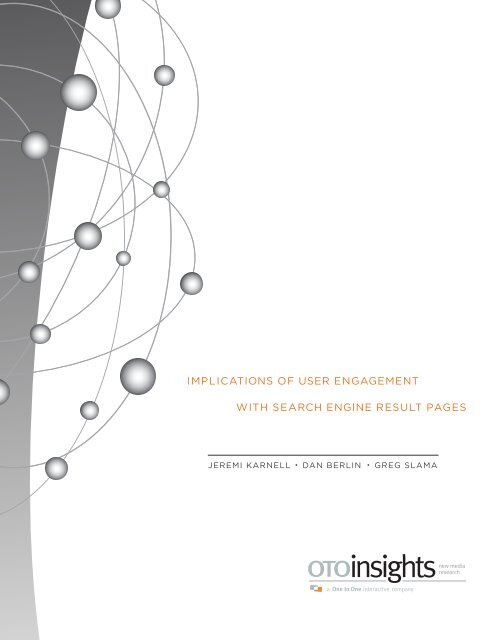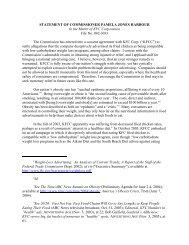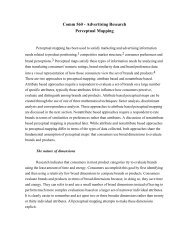ImplIcatIons of User engagement wIth search engIne resUlt pages
ImplIcatIons of User engagement wIth search engIne resUlt pages
ImplIcatIons of User engagement wIth search engIne resUlt pages
Create successful ePaper yourself
Turn your PDF publications into a flip-book with our unique Google optimized e-Paper software.
Implications <strong>of</strong> <strong>User</strong> Engagementwith Search Engine Result PagesJeremi Karnell • Dan Berlin • Greg Slama
executive summary : :As consumer behavior continues to rapidly migrate to an on-demand model wherethe customer controls the purchase cycle, <strong>search</strong> engine usage continues to rise as aprimary means <strong>of</strong> Web navigation. With the massive increase in multimedia contentthat is uploaded, stored, and consumed online, major <strong>search</strong> engines have continuedto evolve beyond simply indexing <strong>pages</strong> <strong>of</strong> text and are now providing resultsbased on a full array <strong>of</strong> video, audio, and image formats. The inclusion <strong>of</strong> thesedigital assets is widely known as Universal Search. As Universal Search becomesa more permanent fixture within <strong>search</strong> engine result <strong>pages</strong> (SERPs), users’interactions with the new generation <strong>of</strong> results should be <strong>of</strong> particular interest tocompanies who are focused on generating quality <strong>search</strong> engine traffic.It is well established that rankings on a SERP have much to do with whether a user islikely to click on a given result and higher rankings can actually have a positive effecton a brand’s perception and ‘likeability’ (MarketingSherpa, 2009). With the onset <strong>of</strong>Universal Search results, this study sought to measure the user impact <strong>of</strong> this newgeneration <strong>of</strong> <strong>search</strong> engine result <strong>pages</strong>. Specifically, we wanted to understand ifthere was a difference in emotional <strong>engagement</strong> with the results and if that wouldimpact click propensity in Paid and Natural Search.Copyright © May 25, 2009, One to One Interactive www.onetooneinteractive.com 1
introduction_serps & seo : :Currently, one <strong>of</strong> the most effective and efficient ways to <strong>search</strong> for digital content isthrough the use <strong>of</strong> a <strong>search</strong> engine such as Google or Yahoo. In fact, a recent Forresterreport indicates that <strong>search</strong> engines are the primary method <strong>of</strong> finding Web sites: 72%<strong>of</strong> adults said that they use <strong>search</strong> engines to find Web sites (Li, 2008). These <strong>search</strong>engines rank Web site <strong>pages</strong> and ads based on various criteria to determine relevanceto a particular <strong>search</strong> (Figure 1).Natural <strong>search</strong>Relevance <strong>of</strong> contentRelevance <strong>of</strong> contentKeyword use it Title attributespaid <strong>search</strong>BidQuality ScoreSite architectureClick Through Rate (CTR)Link popularity (anchor text & topical relevance)Domain ageFigure 1: Search Ranking FactorsWe are now moving into a new generation <strong>of</strong> <strong>search</strong> optimization where digital assetsbeyond pure text come into play. Introduced by Google in May 2007, Universal Searchattempts to index, categorize, and display the most relevant information for a <strong>search</strong>query regardless <strong>of</strong> format (audio, video, images, news, local results, and other richcontent). This <strong>search</strong> method is quickly replacing the traditional text only results andis constantly adjusting to better conform to user behavior and intent. This study servesto highlight the impact that Universal Search results have on consumer <strong>engagement</strong>and click behavior. Our findings underscore the need for marketers to consider theoptimization <strong>of</strong> all digital assets to maintain a competitive advantage as we move tothe next generation <strong>of</strong> SEM.Copyright © May 25, 2009, One to One Interactive www.onetooneinteractive.com 3
quantemo <strong>engagement</strong> index : :While viewing the Web <strong>pages</strong>, participants were connected toOTOinsights’ Quantemo neuromarketing re<strong>search</strong> system. Quantemosimultaneously records biophysical signals in addition to eye and clicktracking information.The recorded biophysical measures are combined into a single representativemeasure <strong>of</strong> physiological <strong>engagement</strong>: the Quantemo Physiological Index, orQPI. The QPI serves as a single point <strong>of</strong> reference for the overall level <strong>of</strong> physical<strong>engagement</strong> (or dis<strong>engagement</strong>) exhibited by a re<strong>search</strong> participant. HigherQPI scores represent stronger physiological <strong>engagement</strong>, while negative QPIscores represent weaker physiological <strong>engagement</strong>.After viewing a page, the participant fills out two surveys: the Geneva EmotionWheel (GEW) and an Aesthetic Likert (1-5) scale. Developed by the re<strong>search</strong>ers atthe Swiss National Re<strong>search</strong> Center in Affective Sciences, the GEW is designed toobtain self-report information on a wide range <strong>of</strong> felt emotions elicited by aparticular event (in the case <strong>of</strong> this study, observing a Web page) (Scherer, 2005).The QPI, aesthetic score, and emotional descriptor scores are combined to formthe Quantemo Engagement Index, or QEI. Calculating the QEI produces a single,representative and holistic measure <strong>of</strong> user <strong>engagement</strong> that allows re<strong>search</strong>ers tocorrelate the objective physiological data <strong>of</strong> the QPI with the subjective, self-reportdata <strong>of</strong> the ratings and emotion scores.Copyright © May 25, 2009, One to One Interactive www.onetooneinteractive.com 7
insights : :SERPs which include video and image results reinforce eyeballs to stay focusedon the first page top paid and natural <strong>search</strong> results.The “Universal w/ Paid” SERP is what visitors will encounter when utilizing <strong>search</strong>engines. As such, we examined the eye-tracking and click results from this SERPtype to determine where each user first looked and clicked. It is no surprise thatthe top paid links received a large number <strong>of</strong> first fixations and clicks(see Figures 7 and 8, respectively).UNIVERSAL w/ paid <strong>search</strong> first fixationUNIVERSAL w/ paid <strong>search</strong> clicks45%12% <strong>of</strong> participants40%35%30%25%20%15%10%5%0%39%toppaid22%pagetop17%video11%1 stlink6% 6%rightpaid1 stpicture% <strong>of</strong> participants1086420731 stLink63Toppaid24otherlink13video13rightpaid21image12multilinks1st click2nd click112ndlinks1newsFigure 7: Universal with Paid First FixationsFigure 8: Universal with PaidHowever, notice the location <strong>of</strong> the video results in both graphs. The video wastypically fixated upon before both the first natural and the right paid links. The videolink also received more clicks than the multilinks and the second natural link. Thesefindings have great implications for those companies who are already optimizing theirWeb site: it may not be enough to optimize just the text. For example, consider theGoogle multilinks which are an indented list <strong>of</strong> site topics determned by the <strong>search</strong>engine when a site is ranked in the first natural position. Figure 8 shows that the videoresults are likely to receive more clicks than the multilinks.Copyright © May 25, 2009, One to One Interactive www.onetooneinteractive.com 8
Videos and image results increase <strong>engagement</strong> on a SERPUtilizing the QEI as an overall measure <strong>of</strong> <strong>engagement</strong>,we found that the SERPs with images and videos weremore engaging to the participants. Figure 13 shows theresults <strong>of</strong> the physiological and emotional <strong>engagement</strong>data produced by the QEI. The results in the middleshow the QEI for the Universal results, which had ahigher <strong>engagement</strong> level than those without Universalresults. This is not surprising given that images andvideos will give the user ‘instant gratification’ with asingle gaze. That is, instead <strong>of</strong> having to read text, theuser will quickly process the images and videos, increasing<strong>engagement</strong>. These findings underscore the impact thatbrand marketing has on <strong>search</strong> marketing strategies.higher<strong>engagement</strong>lower<strong>engagement</strong>0.700.600.500.400.300.200.100.00Quantemo Engagement index0.07naturalonlyResults had images and videos0.37universalw/ paid0.44universalonlyFigure 13: Engagement levels for 4 SERP Types0.08Naturalw/ paidA prime example <strong>of</strong> the salience <strong>of</strong> images, particularly brand logos, is evident from the gaze plot in Figure 14. Thisfigure shows 28 seconds <strong>of</strong> eye tracking for a particular participant. Notice the amount <strong>of</strong> time that the participantspends on the Verizon and Comcast logos in the image area. It took the participant 50 fixations to get to the images,but then spent 38 fixations on the images themselves. There is no doubt that these logos were interesting to theparticipant. This has the implication that further re<strong>search</strong> is warranted to determine if SERPs with brand imagesresult in a higher propensity to make a purchase.Figure 14: 28 Second Gaze PlotCopyright © May 25, 2009, One to One Interactive www.onetooneinteractive.com11
Implications for Marketers• Creating a holistic strategy which considers all <strong>search</strong> interactions• will provide a competitive advantage and drive more engaged visitors• through your SEM activities•• Begin to think about current digital assets and how they can be• leveraged to gain additional reach with the <strong>search</strong> engines• Top Paid results are the highest focal point within typical <strong>search</strong>• results and provide a great branding opportunity• It will continue to be important for brands to maintain high positions• within Paid and Natural results to generate click volume and increase• brand perceptions• Natural Search top results will continue to be the primary driver• <strong>of</strong> <strong>search</strong> engine traffic and should be a major focus on optimization• initiativesImplications for Future Studies• Does media in <strong>search</strong>es change users’ propensity to purchase?• Does brand exposure on a SERP change users’ <strong>engagement</strong> and• click behavior?• Do positional changes in non-text results impact users’ click• propensity and <strong>engagement</strong>?ConclusionsThe findings from this study highlight the importance <strong>of</strong> optimizing media (video &images) for companies who want to drive traffic to their Web site from <strong>search</strong> engines.Traditional SEO efforts may help get links in the top few positions <strong>of</strong> the natural results.But, the Universal <strong>search</strong> paradigm demands that companies pay closer attention totheir optimization <strong>of</strong> digital assets to increase the likelihood <strong>of</strong> inclusion in <strong>search</strong>results. This study provides evidence that videos and images are not only changinga user’s first fixation, but that these media formats positively increase the user’semotional <strong>engagement</strong> during the time they were reviewing the Universal SERP. Thisunderscores the importance <strong>of</strong> branding and the strategic role it should play in <strong>search</strong>engine marketing efforts.Copyright © May 25, 2009, One to One Interactive www.onetooneinteractive.com12
works cited : :Li, C. (2008). How Consumers Find Web Sites. Cambridge, MA:Forrester Re<strong>search</strong>, Inc.MarketingSherpa. (2009). 2009 Search Marketing Benchmark Guide.Warren, RI: MarketingSherpa LLC.Nielsen, J. (2006, April 17). F-Shaped Pattern for Reading Web Content.Retrieved March 19, 2009, from Jakob Nielsen’s Alertbox:http://www.useit.com/alertbox/reading_pattern.htmlScherer, K. (2005). What Are Emotions? And How Can They Be Measured?Social Science Information , 44 (4), 695-729.Copyright © May 25, 2009, One to One Interactive www.onetooneinteractive.com 13
amplifying <strong>engagement</strong>New knowledge about human behavior brought to light by social and neurosciencehas fundamentally called into question the old mental models <strong>of</strong> how advertisingand marketing work. Gone is the notion that consumers make decisions in alinear think-feel-do way and behavior is guided by rational-only principles. Instead,memories, emotions, associations, and thoughts play a primary role in howindividuals relate and ultimately engage with brands.OTOinsights is a primary re<strong>search</strong> <strong>of</strong>fering that is breaking new ground in neuromarketingto <strong>of</strong>fer clients advanced and scientific levels <strong>of</strong> insights into how theirconsumers engage with them across the landscape <strong>of</strong> new media channels.To learn more about OTOinsights, visit www.otoinsights.comComplete One-To-One Solutions for Brands, Agencies, and PublishersOTOinsights is a One to One Interactive company. Established in 1997, One to OneInteractive is the first enterprise to assemble a complete solution for brands, agencies,and publishers executing one-to-one marketing strategies. By bringing together one<strong>of</strong> the nation’s leading digital marketing agencies, the world’s most comprehensiveportfolio <strong>of</strong> permission marketing platforms, unique performance-based social medianetworks, and cutting-edge neuromarketing re<strong>search</strong> techniques, the companies<strong>of</strong> One to One Interactive build informed and creative customer/constituent strategieson the belief that digital media’s ability to enable engaging one-to-one dialogues isthe future <strong>of</strong> marketing.To learn more about One to One Interactive, visit www.onetooneinteractive.comOTOinsights529 Main Street, Charlestown, MA 02129617.425.7300www.otoinsights.cominfo@otoinsights.comCopyright © May 25, 2009, One to One Interactive www.onetooneinteractive.com 14




